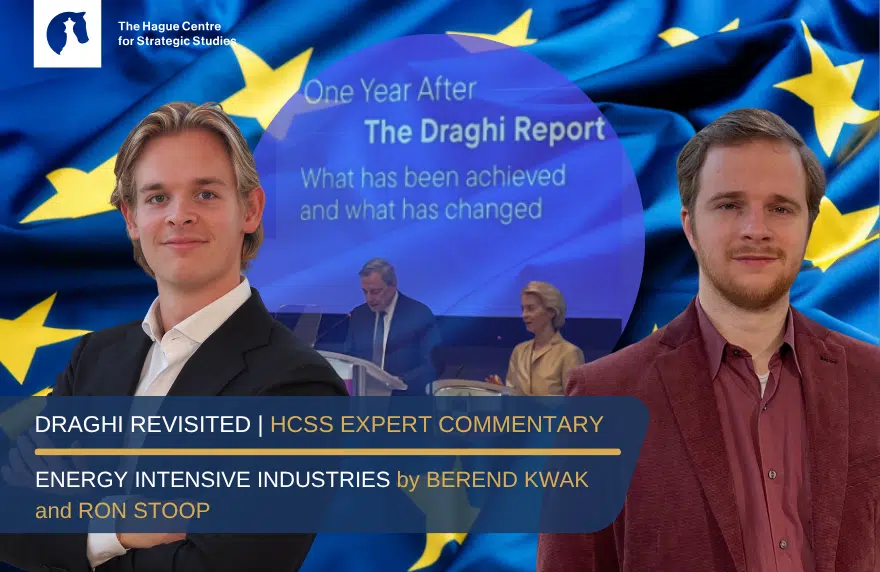One year after Mario Draghi’s landmark report on Europe’s economic future, HCSS launches the second edition of its Draghi Report Series.
Despite political attention, Europe still struggles with dependencies in defence, raw materials, cleantech, and digital domains. Global tensions with both China and the US are mounting, and Europe’s trade model faces unprecedented pressure. Progress has been uneven and often too slow due to coordination, financing and other internal barriers.
Last year, Ron Stoop and Berend Kwak examined the long-term implications of Draghi’s recommendations in a series of interviews with our experts. Now, they return to assess how far Europe has come in addressing his urgent call to secure industrial, technological and economic sovereignty, with HCSS analysts revisiting Draghi’s warnings sector by sector.
For the 8th and final article of our Draghi Revisited series, strategic analyst Davis Ellison examines the EU’s struggle to turn sovereignty into capability, as he explores how far Europe has come on Defence — and how far it still has to go. Europe’s defence ambitions are rising — but progress remains fragmented.
Since the publication of the Draghi Report, what concrete steps have been taken at the EU and member state level in the defence sector, and how effective have they been so far?
Davis Ellison: Since the Draghi Report, most defence-related activity is focused on implementing earlier measures. Around 90 percent of current work is about carrying through the “big bang” reforms of 2022, when initiatives like the European Defence Fund (EDF) and EDIRPA were launched. Discussions continue on streamlining EU funding tools, but no major breakthroughs have followed. The ReArm/Readiness 2030 plan, while important, was more of a continuation of earlier policies than a completely new direction.
Progress has been plagued by chronic industrial fragmentation. Member states still act nationally, which weakens efficiency and scale. Many have turned to off-the-shelf U.S. systems to meet readiness targets quickly. While faster, it undercuts Europe’s ability to build its own capabilities. Also, the U.S. ‘buy American’ push adds pressure and complicates transatlantic cooperation. Pan-European procurement remains limited. The EU still lacks a real mechanism to coordinate or enforce joint acquisition. If there’s one area of progress, it’s space. Programmes like Galileo and Copernicus, and institutions such as the European Space Agency, show that member states can act collectively when frameworks already exist. Space may therefore offer the clearest path for the EU to build genuine European capabilities.
Where do the biggest gaps lie between political ambition and practical implementation, and why do they exist?
Davis Ellison: The biggest gap lies in fragmentation. Defence remains largely outside the EU competences, so ambition often exceeds what Brussels can actually deliver. As Mario Draghi noted at the Rimini conference earlier this year, the EU has a vision but not the means to act on it. There has been a slow build-up of EU-level capacities, but when it comes to defence matters, NATO still dominates.
Additionally, much of the EU’s approach is backward looking, focused on improving existing capabilities, rather than building new strategic capabilities. What is certainly disappointing is that defence policy and procurement by and large remains national. This is reinforced by the single market’s broad carve-out for defence, which exempts the sector from most internal market and competition rules. These protectionist exceptions were meant to preserve sovereignty but now limit integration. Even within the EU institutions, defence responsibilities are scattered and often overlap.
Looking ahead, what should be the EU’s top two or three priorities to stay competitive, and where might it make sense to scale back?
Davis Ellison: A first priority has to do with the gap signalled above. More cross-border innovation and capability development programmes constitute a crucial area for improvement. This is best done in mini-lateral formats of trusted partners that also have a deep, or at least intensifying, operational working relationship.
Another priority should be to rationalise the EU’s defence governance. A stronger role for the Director-General for Defence Industry and Space (DG DEFIS), Andrius Kubilius, could help coordinate efforts. The relationship between DG DEFIS and the European Defence Agency (EDA) is still not clearly structured. The current setup of offices and initiatives does not yet form a coherent system. Creating a more streamlined chain of coordination would make EU defence efforts more effective.
A third priority is to maintain and deepen coordinated exercises with NATO. Aligning schedules and objectives between the EU and NATO would strengthen readiness and avoid duplication. EU Frameworks such as the Permanent Structured Cooperation (PESCO) and the Coordinated Annual Review on Defence (CARD) already offer a platform for this. In the near future, coordination rather than compulsion will likely continue to define the EU’s defence posture. Again, mini-lateral formats within the EU could help bridge the gap between ambition and capability.
If we meet again in a year, what single measurable outcome would convince you that Europe is on the right track in this sector?
Davis Ellison: Genuine rationalisation of EU defence planning. If DG DEFIS and the EDA managed to align PESCO, the EDF, and ReArm under a single, coherent framework, that would be a clear sign of progress. Even a pause on new initiatives could be considered if it meant consolidating what already exists.








